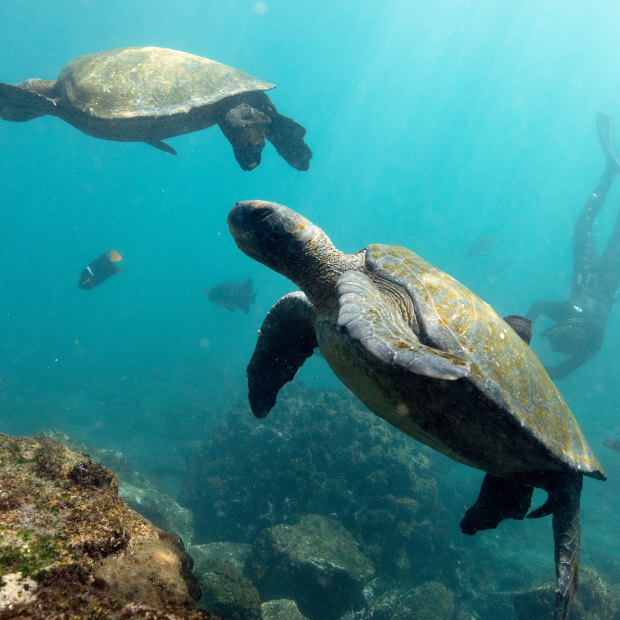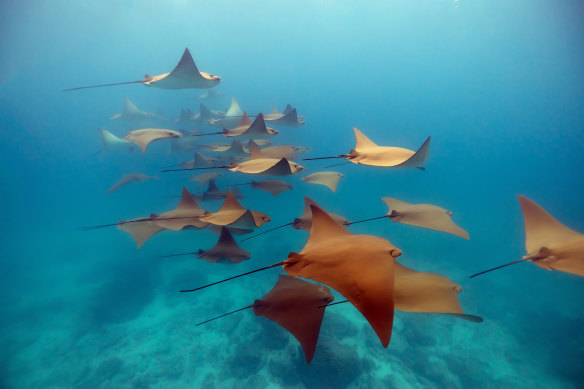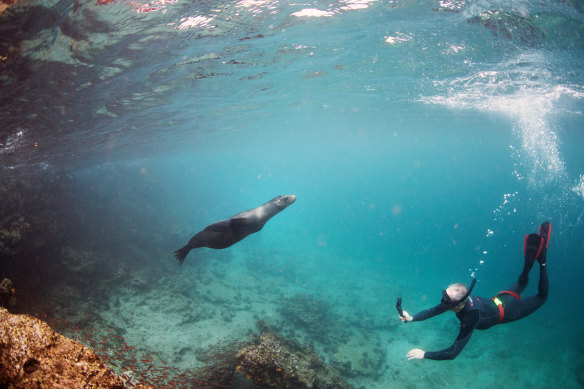This was published 1 year ago
Under threat, the Galapagos still stuns in every way
Long after the Galápagos Islands inspired Charles Darwin, they’ve become a natural selection for bucket-listers.
By Brook Turner

Green turtles and marine life off Isabela Island.
The sea lion ducks its head on the rock ledge, smiling into the wave, like it’s a breeze. For a moment it just hangs there, eyes narrowing as the water percolates around its ears, before launching itself off the rocks, a flash of copper in the receding swell. It’s May 1, 2023, our second day in the Galapagos Islands. The first was spent on Genovesa Island, in the sweltering heat of breeding season, among fraternities of frigate birds, gular pouches puffed up like red balloons, blue-footed boobies, awkward as horn ornaments in the trees, turquoise feet on full display. Occasionally, a wiped-out sea lion peeled itself off the sand, rollicking a metre or so on its stumps, before collapsing again.
This morning has added the fat, pumpkin-coloured iguanas of North Seymour, baking in the sun. The abundance is dazzling; the wildlife so plentiful, sated and generally available to the eye, that the skill has become not treading on it, rather than spotting it.
But the overall impression of these black, volcanic islands, that lie under the unrelenting sun of the equator, is inertia. Which is what makes our first snorkelling expedition beyond the nursery slope of the beach a revelation.
Jumping off Zodiacs, that land-locked sluggishness vanishes, awkwardness becoming its opposite – ballet. The first sea lion is quickly followed by a raft of others, spiralling around each other in play. A small, dark pup shoots up, inches from my face, then reverses, hanging upside down, to survey me with his goblin eyes. From there, sightings turn exponential. Sea lions give way to the first turtle, its back close enough to touch. As it glides into the middle distance, a perfect scale-model of Godzilla dives into the water, attaching itself to a mossy rock by its Fu-Manchu claws.
The world’s only marine iguana exemplifies the rich and remote food chain, and consequent adaptation, that has made these 19 islands, almost 1000 kilometres off Ecuador’s coast, a UNESCO World Heritage “living museum and showcase of evolution”.
Five major ocean currents converge in the Galapagos, including the deep, cold, nutrient-rich Humboldt and Cromwell currents, and the warmer Panama current. Shoals of bass, grouper and sardines swim with schools of brilliantly coloured tropical fish – rainbow wrasse, angel, damsel, clown and parrot fish – through water milky with nutrients. Mesmerising as they are, these constellations of fish soon become a backdrop to the hammerhead and reef sharks below, that in turn segue into scenery for the sea lions’ ballet, or penguins torpedoing through the water as if shot out of a cannon.

Golden rays in Gardner Bay, Española Island.
A Zodiac detour into the mangroves yields a fever of golden rays gliding through the brackish water. Not that you need to venture that far. Forty or so dolphins shred the sea outside our ship window one day over lunch. A day later, we spot a giant manta ray right outside our cabin, undulating across the surface like a sheet on a clothesline.
Of course, there’s a problem with all this. The water is meant to be chilly as the Humboldt current comes into play. Wetsuits have been recommended – yet the unexpectedly mild water temperature means they’re not really needed. Even before the World Meteorological Organisation (WMO) declares an El Nino event, it’s clear that May 1, 2023 is a real May Day in this World Heritage-listed petri dish. Ecuadorian guides show us torrential rains in their hometowns on their phones, another El Nino sign and so remarkable, their families have sent video. “I know, I promised you a dry landing,” one guide says after a sodden Zodiac arrival. “But the boy child’s been born and he’s angry.”
Fat as ticks, those sea lions will find the going tough without the upwelling from the cold currents as the season progresses. And by the time the WMO confirms the boy child months later, sea ice is found to have been at a record low in that other bucket-list staple, Antarctica. And they are a pair, Antarctica and the Galapagos; the cool and warm bucket-list poles.
Our ship, Silversea’s Silver Origin, is packed with intergenerational family groups. A purpose-built prism of floor-to-ceiling glass launched three years ago, it boasts the sort of impressive green credentials that will become standard. Inevitably, though, given the times, there’s a last-days-of-Rome feel. The food, care of the excellent young Ecuadorian chef Andrea Cruz, is remarkable. By day, you meet fish socially. By night, you eat their distant relatives.
Part of that allure is the abundance, diversity and proximity of wildlife. In terms of birds alone, over a fortnight we see everything from frigates, like sleek carbon-fibre boomerangs, to clouds of red and blue-footed boobies plummeting out of the air. Arriving on Espanola Island, we trip over hundreds of albatross, mild-faced and friendly as labradors. A fortnight ago there was one, our guide tells us; last week, 40. On Fernandina Island, a magnificent Galapagos hawk flies in for his close-up, perched in a tree as camera shutters whir around him. On Floreana, a flock of prawn-pink flamingos doubles in the mirror of a lagoon before being engulfed in pink and gold as the sun flares out on the empty, white-sand beach.

A sea lion joins snorkellers at Rabida Island.
Like Antarctica, part of the Galapagos charm is its remoteness, the dizzying difficulty and cost of getting here, and the peril that lurks just beyond.
Not only is Galapagos 1000 kilometres from the nearest mainland, 97 per cent of it was declared a national park in 1959, the surrounding marine reserve extended to 200,000 square kilometres last year. Only 1600-odd passengers are allowed within the 80,000-square- kilometre park at any one time. Guides can supervise a maximum of 16 people onshore, where we never run into another group.
On-board radar shows huge fishing trawlers lurking off the limits of the marine conservancy, where the Ecuadorian navy discovered an armada of 340 Chinese vessels in 2020.
This is a world now largely vanished, saved here only because it was lost for so long. That, too, is a large part of its appeal. As its World Heritage listing underlines, the Galapagos is our modern Garden of Eden, the laboratory of the biologist that, as Scientific American noted in 2000, “has been responsible for more – and for more drastic – modifications of the average person’s world-view” than anyone.
There is something of the pilgrimage to our voyage, as underlined by the ship’s name and bounteous copies of both On the Origin of Species and Adrian Desmond and James Moore’s magisterial Darwin biography in its
library. Reading the latter in breaks in the boot-camp schedule necessitated by the heat and tight regulation of the National Park Service, brings not just that story, but its near-miss nature to life.
This is a world now largely vanished, saved here only because it was lost for so long … our modern Garden of Eden.
The original late bloomer, Darwin was a refugee from both medicine and a theology degree when he joined HMS Beagle as its naturalist in 1831. Chosen by its captain for his social rather than scientific skills, he had much to prove, and made a mixed fist of proving it.
Not only did he fail to ensure the finches, later crucial to his theory, were labelled by locality, he initially dismissed the significance of the giant tortoises, keeping them instead as pantry staples, the all-important shells thrown overboard on the Beagle’s return voyage from charting the coast of South America.

White-tip reef sharks at North Seymour Island. These are one of the most abundant shark species in the Galapagos.
Nevertheless, Galapagos haunted Darwin for all the decades it took to finally publish On the Origin of Species in 1859. Even for a cruise visitor, that power remains. It’s one of those very rare places you begin to miss even while you’re there.
A week after snorkelling at North Seymour, we arrive at Fernandina, the youngest island in the still-evolving archipelago, as the geologist tells us, or “the devil’s own country” as its original visitors dubbed it, the serrated volcanic rock that covers it like knives laid blades-up. A few years ago, Fernandina starred in a piece of viral 2016 BBC Planet Earth footage in which a newly hatched marine iguana, cute as an emoji, evaded a dozen homicidal racer snakes on its first, four-and-a-half minute sprint across the beach. As an illustration of the mind-numbing brutality of survival of the fittest, it was so compelling it garnered 29 million views.
On a misty evening in this new wet season, however, it seems almost achingly benign as 16 of us emerge from another wet landing onto another white beach, its centre staked off. Under the sand, a new generation of marine iguanas gestate, our guides inform us. Those satanic rocks the racers slithered down are a stone’s throw away across the beach.
Today, as pelicans preen on the rocks, a mess of 30 or so fat iguanas – “imps of darkness” as Darwin called them – pile together on a log a few feet away, recovering heat after their daily dive. The only intimation of mortality is the bleached bones of various whales; the only disturbance a sleeping sea lion suddenly barking at a pup as it attempts to suckle.
Tough love, you think, until a younger and cuter pup appears, barking at the interloper to reclaim what is in fact its mother, and settling in to feed. Sometimes, even on the world’s most perilous island, nature has to rest. Sometimes even the Galapagos just smiles.
To read more from Good Weekend magazine, visit our page at The Sydney Morning Herald, The Age and Brisbane Times